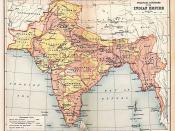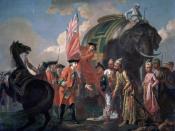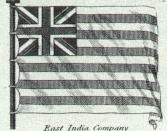In the 18th century, Britain seized the opportunity offered by its East India Company to establish a mercantile colony. European merchants had been trading in India since the 16th century; however, the largest trade organization in India during the 17th century was the English East India Company. Beginning in that time period, Britain formed and maintained an economic relationship with India. Confrontations in the 18th century between the English East India Company and the French East India Company ultimately led to the British "occupation" of India. Both companies contested for Indian states around their lands, for whoever held the most profitable lands would have the most profits. Indians were drawn into the conflict as both British and French recruited sepoys to assist in the battles.
The most favorable area to control was Bengal. According to the French traveler, Bernier: "The knowledge I have acquired of Bengal in two visits inclines me to believe that it is richer than Egypt.
It exports in abundance cottons and silks, rice, sugar and butter. It produces amply for it's own consumption of wheat, vegetables, grains, fowls, ducks and geese. It has immense herds of pigs and flocks of sheep and goats."
In 1756, Siraj al-Dawla, the Nawab of Bengal, invaded Calcutta (the principal fort of the East India Company) in order to gain control over the East India Company. There, in an episode that became known as the Black Hole of Calcutta, 123 British were kept prisoners and died in a small, locked room. In retaliation, Robert Clive was sent to regain Calcutta and essentially Bengal. Robert Clive led the outnumbered British army to victory against the poorly trained Indian troops of Siraj al-Dawla. According to Clive, there were "...about fifteen thousand horse and thirty-five thousand foot about fifteen thousand horse and thirty-five...



Compliments
Thank you so much for this essay. It provides great information in a clear and easy to read fashion. on my favorites list!
1 out of 1 people found this comment useful.